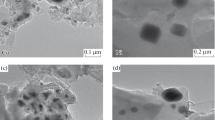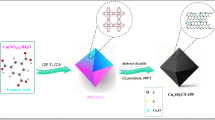Abstract
A copper pyromellitic acid template is used to prepare the Cu@C compound by calcination under nitrogen and further synthesize the CuO@C compound by aerobic calcination. Transmission electron microscope observation shows that both Cu nanoparticles and CuO nanoparticles can be uniformly coated in nanoporous carbon, indicating that the experimental method is feasible. Using the precursor HKUST-1 and the in situ heating reaction technology of a high-resolution transmission electron microscope to observe the Cu@C nanocomposites at different temperatures, the relationship between product and temperature was discussed. When heated to 350 °C, copper atoms begin to aggregate to form nanoparticles. With the increasing temperature, the particle size of nanoparticles increases from 30 to 60–70 nm. This change provides a reliable basis for preparing nanomaterials by carbonizing metal-organic frameworks as precursors or templates. In addition, the mechanism and influencing factors of porous carbon prepared with metal-organic frameworks as a precursor are discussed. Precise temperature control is a key step in the preparation of carbon-based metal nanoparticle composites with controllable sizes.












Similar content being viewed by others
References
Liu D, Gu W, Zhou L, Wang L, Zhang J, Liu Y, Lei J (2022) Recent advances in MOF-derived carbon-based nanomaterials for environmental applications in adsorption and catalytic degradation. Chem Eng J 427:131503. https://doi.org/10.1016/j.cej.2021.131503
Cai G, Yan P, Zhang L, Zhou HC, Jiang HL (2021) Metal–organic framework-based hierarchically porous materials: Synthesis and applications. Chem Rev 121:12278–12326. https://doi.org/10.1021/acs.chemrev.1c00243
Gandara-Loe J, Pastor-Perez L, Bobadilla L, Odriozola J, Reina T (2021) Understanding the opportunities of metal–organic frameworks (MOFs) for CO2 capture and gas-phase CO2 conversion processes: a comprehensive overview. React Chem Eng 6:787–814. https://doi.org/10.1039/D1RE00034A
Yang W, Zhao Q, Zhou Y, Cui Z, Liu Y (2022) Research progress of metal organic frameworks/carbon-based composites for microwave absorption. Adv Eng Mater 24:2100964. https://doi.org/10.1002/adem.202100964
Shi Y, Feng D, Ahmad S, Liu L, Tang J (2022) Recent advances in metal–organic frameworks–derived carbon-based materials in sulfate radical-based advanced oxidation processes for organic pollutant removal. Chem Eng J 454:140244. https://doi.org/10.1016/j.cej.2022.140244
Liu Y, Wang Y, Zhao S, Tang Z (2022) Metal–organic framework-based nanomaterials for electrocatalytic oxygen evolution. Small Methods 6:2200773. https://doi.org/10.1002/smtd.202200773
Habib NR, Asedegbega-Nieto E, Taddesse AM, Diaz I (2021) Non-noble MNP@ MOF materials: synthesis and applications in heterogeneous catalysis. Dalton Trans 50:10340–10353. https://doi.org/10.1039/D1DT01531A
Qin L, Pan Y, Yu L, Huai R, Yang L, Dou Y, Zhou Z (2021) In situ cleavage and rearrangement synthesis of an easy-to-obtain and highly stable Cu (II)-based MOF for efficient heterogeneous catalysis of carbon dioxide conversion. CrystEngComm 23:6307–6314. https://doi.org/10.1039/D1CE00888A
Choe JH, Kim H, Hong CS (2021) MOF-74 type variants for CO2 capture. Mater Chem Front 5:5172–5185. https://doi.org/10.1039/D1QM00205H
Lei L, Cheng Y, Chen C, Kosari M, Jiang Z, He C (2022) Taming structure and modulating carbon dioxide (CO2) adsorption isosteric heat of nickel-based metal organic framework (MOF-74 (Ni)) for remarkable CO2 capture. J Colloid Interf Sci 612:132–145. https://doi.org/10.1016/j.jcis.2021.12.163
Wang Y, Wen Z, Wang CC, Yang CC, Jiang Q (2021) MOF-derived Fe7S8 nanoparticles/N-doped carbon nanofibers as an ultra-stable anode for sodium-ion batteries. Small 17:2102349. https://doi.org/10.1002/smll.202102349
Meng C, Cao Y, Luo Y, Zhang F, Kong Q, Alshehri AA, Alzahrani KA, Li T, Liu Q, Sun X (2021) A Ni-MOF nanosheet array for efficient oxygen evolution electrocatalysis in alkaline media. Inorg Chem Front 8:3007–3011. https://doi.org/10.1039/D1QI00345C
Huang K, Rong C, Zhang W, Yang X, Fan Y, Liu L, Yang Z, Chen W, Yang J (2021) MOF-assisted synthesis of Ni, Co, Zn, and N multidoped porous carbon as highly efficient oxygen reduction electrocatalysts in Zn–air batteries. Mater Today Energy 19:100579. https://doi.org/10.1016/j.mtener.2020.100579
Liu B, Shioyama H, Akita T, Xu Q (2008) Metal-organic framework as a template for porous carbon synthesis. J Am Chem Soc 130:5390–5391. https://doi.org/10.1021/ja7106146
Xiao X, Peng S, Wang C, Cheng D, Li N, Dong Y, Li Q, Wei D, Liu P, Xie Z (2019) Metal/metal oxide@ carbon composites derived from bimetallic Cu/Ni-based MOF and their electrocatalytic performance for glucose sensing. J Electroanal Chem 841:94–100. https://doi.org/10.1016/j.jelechem.2019.04.038
Nik Zaiman NFH, Shaari N, Harun NAM (2022) Developing metal-organic framework-based composite for innovative fuel cell application: an overview. Int J Energy Res 46:471–504. https://doi.org/10.1002/er.7198
Huang G, Yang L, Ma X, Jiang J, Yu SH, Jiang HL (2016) Metal–organic framework-templated porous carbon for highly efficient catalysis: the critical role of pyrrolic nitrogen species. Chem Eur J 22:3470–3477. https://doi.org/10.1002/chem.201504867
Ma X, Li L, Chen R, Wang C, Li H, Wang S (2018) Heteroatom-doped nanoporous carbon derived from MOF-5 for CO2 capture. Appl Surf Sci 435:494–502. https://doi.org/10.1016/j.apsusc.2017.11.069
Tao Y, Zhang G, Xu H (2022) Grand canonical Monte Carlo (GCMC) study on adsorption performance of metal organic frameworks (MOFs) for carbon capture. Sustain Mater Techno 32:e00383. https://doi.org/10.1016/j.susmat.2021.e00383
Chen W, Rakhi R, Hedhili MN, Alshareef HN (2014) Shape-controlled porous nanocarbons for high performance supercapacitors. J Mater Chem A 2:5236–5243. https://doi.org/10.1039/C3TA15245F
Aijaz A, Fujiwara N, Xu Q (2014) From metal–organic framework to nitrogen-decorated nanoporous carbons: high CO2 uptake and efficient catalytic oxygen reduction. J Am Chem Soc 136:6790–6793. https://doi.org/10.1021/ja5003907
Xu X, Cao R, Jeong S, Cho J (2012) Spindle-like mesoporous α-Fe2O3 anode material prepared from MOF template for high-rate lithium batteries. Nano Lett 12:4988–4991. https://doi.org/10.1021/nl302618s
Kim TK, Lee KJ, Cheon JY, Lee JH, Joo SH, Moon HR (2013) Nanoporous metal oxides with tunable and nanocrystalline frameworks via conversion of metal–organic frameworks. J Am Chem Soc 135:8940–8946. https://doi.org/10.1021/ja401869h
Yang SJ, Kim T, Im JH, Kim YS, Lee K, Jung H, Park CR (2012) MOF-derived hierarchically porous carbon with exceptional porosity and hydrogen storage capacity. Chem Mater 24:464–470. https://doi.org/10.1021/cm202554j
Jiang HL, Liu B, Lan YQ, Kuratani K, Akita T, Shioyama H, Zong F, Xu Q (2011) From metal–organic framework to nanoporous carbon: toward a very high surface area and hydrogen uptake. J Am Chem Soc 133:11854–11857. https://doi.org/10.1021/ja203184k
Hu M, Reboul J, Furukawa S, Torad NL, Ji Q, Srinivasu P, Ariga K, Kitagawa S, Yamauchi Y (2012) Direct carbonization of Al-based porous coordination polymer for synthesis of nanoporous carbon. J Am Chem Soc 134:2864–2867. https://doi.org/10.1021/ja208940u
Lim S, Suh K, Kim Y, Yoon M, Park H, Dybtsev DN, Kim K (2012) Porous carbon materials with a controllable surface area synthesized from metal–organic frameworks. Chem Commun 48:7447–7449. https://doi.org/10.1039/C2CC33439A
Feng L, Wang KY, Day GS, Ryder MR, Zhou HC (2020) Destruction of metal–organic frameworks: positive and negative aspects of stability and lability. Chem Rev 120:13087–13133. https://doi.org/10.1021/acs.chemrev.0c00722
Rao R, Ma S, Gao B, Bi F, Chen Y, Yang Y, Liu N, Wu M, Zhang X (2023) Recent advances of metal-organic framework-based and derivative materials in the heterogeneous catalytic removal of volatile organic compounds. J Colloid Interf Sci 636:55–72. https://doi.org/10.1016/j.jcis.2022.12.167
Yu Q, Jin R, Zhao L, Wang T, Liu F, Yan X, Wang C, Sun P, Lu G (2021) MOF-derived mesoporous and hierarchical hollow-structured In2O3-NiO composites for enhanced triethylamine sensing. ACS Sens 6:3451–3461. https://doi.org/10.1021/acssensors.1c01374
Das R, Pachfule P, Banerjee R, Poddar P (2012) Metal and metal oxide nanoparticle synthesis from metal organic frameworks (MOFs): finding the border of metal and metal oxides. Nanoscale 4:591–599. https://doi.org/10.1039/C1NR10944H
Sun JK, Xu Q (2014) Functional materials derived from open framework templates/precursors: synthesis and applications. Energy Environ Sci 7:2071–2100. https://doi.org/10.1039/C4EE00517A
Wu YA, Li L, Li Z, Kinaci A, Chan MK, Sun Y, Guest JR, McNulty I, Rajh T, Liu Y (2016) Visualizing redox dynamics of a single Ag/AgCl heterogeneous nanocatalyst at atomic resolution. ACS Nano 10:3738–3746. https://doi.org/10.1021/acsnano.6b00355
Xu D, Zhang D, Zou H, Zhu L, Xue M, Fang Q, Qiu S (2016) Guidance from an in situ hot stage in TEM to synthesize magnetic metal nanoparticles from a MOF. Chem Commun 52:10513–10516. https://doi.org/10.1039/C6CC05366A
Xu D, Pan Y, Chen M, Pan Q, Zhu L, Xue M, Zhang D, Fang Q, Qiu S (2017) Synthesis and application of a MOF-derived Ni@ C catalyst by the guidance from an in situ hot stage in TEM. RSC Adv 7:26377–26383. https://doi.org/10.1039/C7RA03162A
Funding
The authors are grateful to the High Level Talent Project of Zhongshan City (No. KYG2202 and KYG2302), Characteristic Innovation Project of Ordinary Colleges and Universities in Guangdong Province (No. 2022KTSCX339), Special Project in Key Fields of General Universities in Guangdong Province (No. 2022ZDZX3086), 2021 High-level Talents Research Initiative Project (No. KYG2101), and the Social Public Welfare and Basic Research Project of Zhongshan City (No. 201723124041404).
Author information
Authors and Affiliations
Contributions
Jianhui Zhang: investigation, resources, funding acquisition, methodology, software, and writing—original draft. Wenhua Zhao: funding acquisition and writing—review and editing. Jun Wang: funding acquisition and writing—review and editing. Meiyun Lai: writing—review and editing. Xuexue Pan: data curation, project administration, conceptualization, and writing—review and editing.
Corresponding author
Ethics declarations
Conflict of interest
The authors declare no competing interests.
Additional information
Publisher’s note
Springer Nature remains neutral with regard to jurisdictional claims in published maps and institutional affiliations.
Rights and permissions
Springer Nature or its licensor (e.g. a society or other partner) holds exclusive rights to this article under a publishing agreement with the author(s) or other rightsholder(s); author self-archiving of the accepted manuscript version of this article is solely governed by the terms of such publishing agreement and applicable law.
About this article
Cite this article
Zhang, J., Zhao, W., Wang, J. et al. In situ transmission electron microscopy to monitor phase transitions in metal-organic frameworks. J Nanopart Res 25, 110 (2023). https://doi.org/10.1007/s11051-023-05767-6
Received:
Accepted:
Published:
DOI: https://doi.org/10.1007/s11051-023-05767-6




